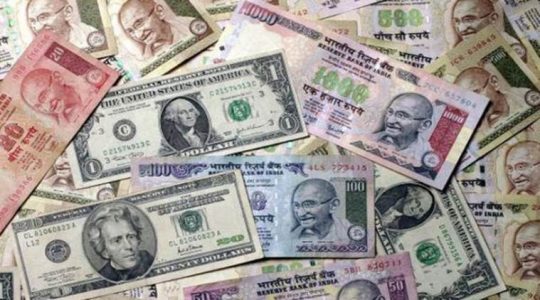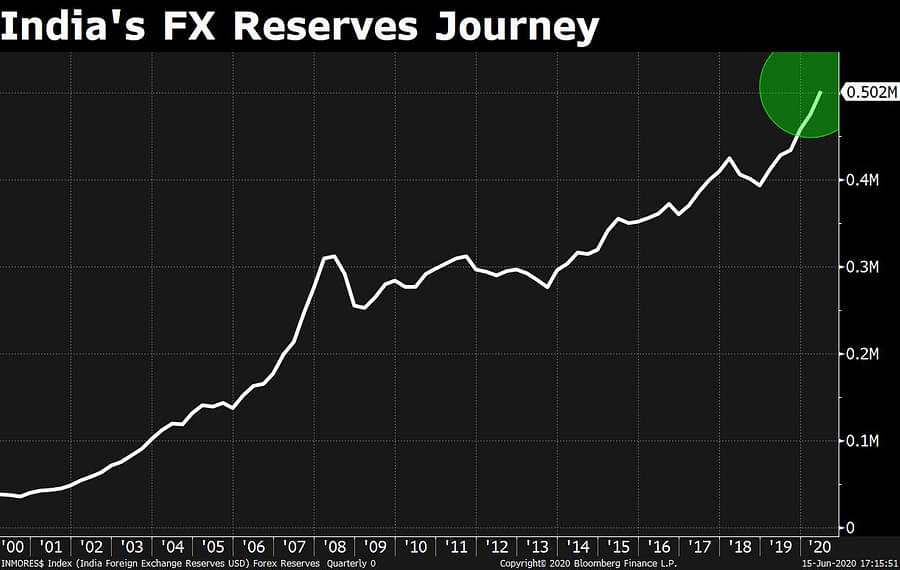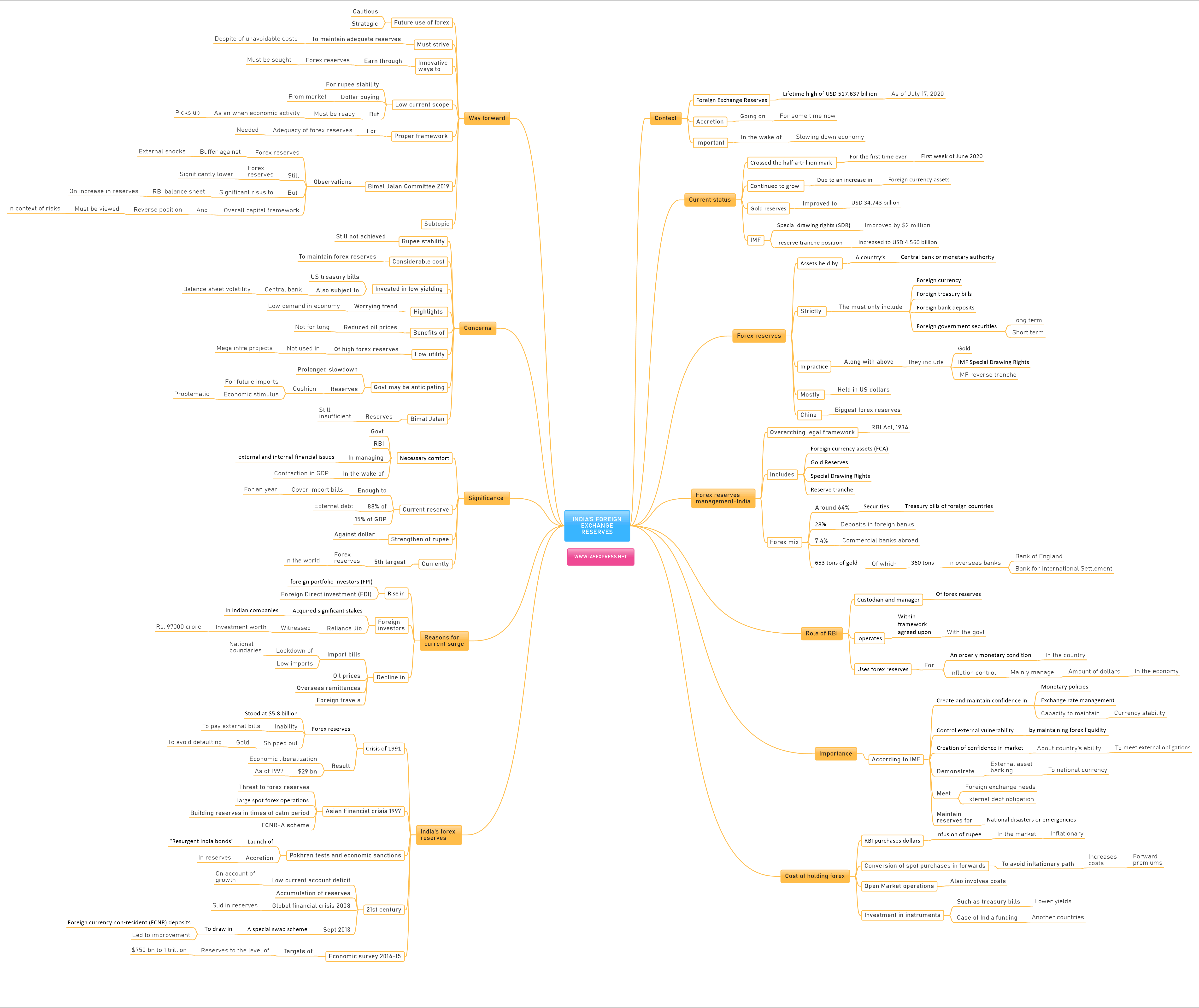India’s Forex Reserves: Recent trends

From Current Affairs Notes for UPSC » Editorials & In-depths » This topic
IAS EXPRESS Vs UPSC Prelims 2024: 85+ questions reflected
The RBI data released recently showed that the accretion of Foreign Exchange Reserves continues as it recorded a fresh lifetime high of USD 517.637 billion as of 17th July, 2020. The accretion has been going on for some time now despite the slowdown and the COVID-19 lockdown situation has created quite a lot of interest as to how this is happening.
What is the current status of Forex exchange reserves?
- The forex reserves had crossed the half-a-trillion mark for the first time ever in the first week of June 2020 to reach USD 501.703 billion.
- As of July 17, the reserves continued to grow due to an increase in foreign currency assets (FCA), which is a major component of India’s forex reserves.
- Gold reserves also improved to USD 34.743 billion, as per the RBI data.
- The special drawing rights (SDR) with the International Monetary Fund improved to USD 1.455 billion by rising by USD 2 million.
- The country’s reserve position with the IMF also increased to USD 4.560 billion during this period.
What are Foreign Exchange Reserves (Forex reserves)?
- Forex reserves are the assets held by a country’s central bank or monetary authority. They are held as a form of different assets like currency, gold, etc.
- In a strictly conservative definition, a country’s forex reserves should contain foreign currency, foreign treasury bills, foreign bank deposits, foreign government securities (both long and short term)
- But, in practice, countries around the globe hold gold, IMF Special Drawing Rights, and Reserve Tranche also.
- Most Forex reserves are held in US dollars. China is the largest foreign currency reserve holder in the world.
How Forex reserves are kept in India?
- The RBI Act, 1934 provides the overarching legal framework for the deployment of reserves in different foreign currency assets and gold.
- In India forex reserves includes:
- Foreign currency assets (FCA)– These are assets that are valued based on a currency other than Rupee largely expressed in dollar terms.
- Gold Reserves
- Special Drawing Rights– It is an international reserve asset created by the IMF to supplements official reserves of the member countries. It is not a currency and its value is calculated from a weighted basket of major currencies: US dollars, Euro, Japanese Yen, Chinese Yuan, and British Pound.
- Reserve tranche– Reserve tranche is a portion of the quota of currency each member country must provide to the IMF and it can be utilized for contributing the country’s own purposes.
- Around 64% of the forex reserves in India are held in securities like treasury bills of foreign countries (mainly US), 28% are deposited in foreign central banks, and 7.4% are deposited in commercial banks abroad.
- India, as of March 2020, held 653 tons of gold with 360 tons being held in overseas banks such as Bank of England and Bank for International settlements. The remaining gold is held domestically.
What is the role of RBI in forex reserve management?
- The RBI is the custodian and manager of forex reserves in India. It operates within the overall framework agreed upon with the government.
- The RBI uses forex reserves for an orderly monetary condition in the country. As an authority to control inflation, forex reserves, mainly management of the amount of dollars present in the market.
What is the importance of forex reserves?
According to the IMF, Typically, official foreign exchange reserves are held in support of a range of objectives including to:
- Create and maintain confidence in the monetary policies and exchange rate management by the government including the capacity to intervene in maintaining the stability of the national currency;
- Control external vulnerability by maintaining forex liquidity to absorb shocks in times of crisis or a situation of curtailed access to borrowing;
- Creation of confidence in the market that a country can meet its external obligations;
- demonstrate the external asset backing of domestic currency;
- Help the government in meeting its foreign exchange needs and external debt obligations;
- maintain a reserve for national disasters or emergencies.
Is there any cost involved in holding Foreign exchange reserves?
- Though there are many advantages to the country, holding them also comes at a cost.
- When RBI purchases dollars in the spot, it leads to the infusion of rupee into the system which leaves an inflationary effect on the economy.
- Since the RBI does not want such actions to create inflationary pressure, so, it converts spot purchases into forwards. This process adds a direct cost because of the forward premiums.
- If RBI opts for open market operations (OMOs) to mop up excess liquidity, that also involves costs.
- RBI invests these dollars in instruments such as US treasuries, which offer negligible returns, owing to lower yields. But experts say these are unavoidable costs.
- India earns next to nothing for the foreign reserves it holds—actually, this way India finances another country when it has a significant financing needs.
- It is very difficult to state the level of reserves considered adequate by RBI. Though there are costs involved, the costs to benefit cannot be quantified by any model. Globally, there has been no study on the adequacy of reserves. In such an environment, RBI will have to go through experiences.
India’s Forex reserves since 1991: an overview
- Though Forex reserves as strongest ever, this was not the case always. The crisis of 1991 and beyond, there have been a number of instances when India was insecure about the levels of reserves.
- During the 1991 financial crisis, India’s forex reserves stood at $5.8 billion as of March 1991 and dwindled further during that year, prompting the country to ship out its gold to avoid a default. This crisis eventually led to the liberalization of the country’s economy.
- A by-product of those reforms was an increase in reserves, which, according to the RBI’s annual reports, was driven in large part by foreign direct investment in the early years. By March 1997, India held the US $29 billion in forex reserves.
- The year 1997 brought the Asian Financial crisis, the first forex reserve test since 1991. Through large spot forex operations like selling forex, the building of reserves in the period of calms, the FCNR-A scheme under which the forex risks were first borne by the RBI and then the government, India maintained a reserve of $ 27 billion at the end of the year.
- The reserves were also tested by 1998 Pokhran Nuclear tests induced economic sanctions. The government responded with the launch of the “Resurgent India bonds” which resulted in an accretion of foreign currency assets.
- At the beginning of the 21st century, Bimal Jalan, then RBI governor, detailed the emerging thinking on forex reserves, making it clear the central bank would continue to build a buffer.

- Low Current account deficit during this period (2001-07) helped the accumulation of reserves.
- The global financial crisis of 2008 brought the external sector under stress and forex reserves as a percentage of GDP slid down.
- As volatility hit the global markets, foreign investors saw the Indian market vulnerable. As the currency tumbled and the designed monetary policy response failed to act as protection, the RBI sold dollars heavily.
- As of August of 2013, forex reserves of about $275 billion were adequate to cover less than seven months of imports.
- On September 4 that year, the central bank announced a special swap scheme to draw in foreign currency non-resident deposits. The central bank offered a special swap window at a fixed rate of 3.5% per annum for FCNR(B) (Foreign Currency Non-Resident Account) funds mobilized for a minimum tenor of three years or more. Banks raised $26 billion under the scheme.
- Since then, the forex reserves are increasing. Officially, the RBI targets neither a particular exchange rate nor foreign exchange reserves, and maintains such interventions by it to just reduce volatility in the forex market
- But in the process of supporting weakening rupee, RBI needs to buy the dollar, ultimately, leading to higher forex build-ups.
- Citing the example of China, the Economic Survey 2014–15 said India could target foreign exchange reserves of US$750 billion to $1 trillion.
What is the reason for the current rise in the forex reserves?
The current forex reserves rise despite the slowdown in the economy is because of the following reasons:
- The major reason is the rise in investment in foreign portfolio investors (FPI) in Indian stocks and foreign direct investments (FDIs).
- Foreign investors have acquired significant stakes in Indian companies in the last two months. Reliance Industries subsidiary, Jio Platforms, has witnessed a series of foreign investments totaling Rs 97,000 crore.
- After pulling out Rs 60,000 crore each from debt and equity segments in March, Foreign Portfolio Investments (FPIs), who expect a turnaround in the economy later this financial year, have now returned to the Indian markets and bought stocks worth over $2.75 billion in the first week of June.
- On the import bill side, the fall in crude oil prices has brought down the oil import, saving precious foreign exchange.
- Similarly, overseas remittances and foreign travels have fallen steeply – down 61 percent in April from $12.87 billion. The months of May and June are expected to show a further decline in dollar outflows.
What is the significance of rising forex reserves?
- The rising forex reserves give a necessary comfort to the government and the RBI in managing India’s external and internal financial issues at a time when the economic growth is set to contract by around 1.5% in 2020-21.
- The current forex reserve is big enough to cover the import bill of the country for a year.
- They are about 88% of India’s external debt which stood at $564 billion as of December 2019.
- The rising reserves can also help the rupee to strengthen against the dollar. The foreign exchange reserves to GDP ratio is around 15 percent.
- India has accumulated the world’s fifth-largest foreign exchange reserves (after China, Japan, Switzerland, and Russia) at more than $500 billion, making it a bright spot in an otherwise dismal economy.
- Reserves will provide the necessary confidence to markets that India can meet its external obligations, demonstrate the backing of domestic currency by external assets, assist in meeting the forex needs.
Are there any concerns regarding the highest ever reserves?
- Though the current reserves stand at an all-time high, there are few concerns regarding its stability and utility.
- One of the fundamental use of forex reserves is ensuring rupee stability. That is also not happening to look at the current figures.
- There is a considerable cost attached to the maintenance of forex reserves as discussed above.
- If this is the case, over-reliance on forex reserves to provide this stimulus is a little problematic as the potential of the floating funds like FPI to change directions is huge in the current market conditions.
- Also, forex reserves are invested in low-yielding assets such as U.S. treasuries and are subject the central bank balance sheet to volatility.
- While the reduction in imports have helped the reserves to swell, it also highlights a worrying trend of reduced demand in the economy. A growing market like India, India needs to import capital goods and machinery to keep its industrial sector humming.
- The rise on account of reduced import bill may not hold for long as when the economic activity will kickstart, the current account deficit will increase as the reserves will be spent heavily.
- while the reserves give a ray of hope, one must scrutinize its utility. There is an issue of unused reserves. Not using them for mega-projects like those of infrastructure is a lost opportunity according to some economists.
- The government must be anticipating the need for economic stimulus in the coming days and banking on the reserves to fund this stimulus.
- Having $500 billion is still an insufficient amount according to Ex-RBI governor Bimal Jalan.
What is the way forward?
- Though the current reserves basket is full, the future path must be cautiously. The high forex reserves must not make us complacent and we must keep striving to maintain adequate reserves despite unavoidable current account deficit.
- Ways to invest forex reserves to earn through them must be sought as foreign currency with RBI does not earn anything and the investment in US securities earnings are negligible.
- Though currently, we have less scope for putting forex reserves to good use like rupee stability and money infusion in the market through buying dollars, we must be ready for an economic kickstart as an when it begins.
- The adequacy of the reserves is a debatable issue among the economists around the world. As part of a wider review of the RBI’s economic capital framework in 2019, a committee headed by former governor Jalan made a few important observations with regards to forex reserves.
- First, while forex reserves provide the economy with a buffer against external stress, they give rise to significant risks for the RBI balance sheet. The committee pointed to the fact that mark-to-market losses of 1.1-1.5% of GDP have been experienced during certain periods, although the RBI has never suffered an overall loss in any year.
- The Jalan committee was urging that the overall economic capital framework and reserve position of the central bank be viewed in the context of the risks that lie on its balance sheet.
- The committee also noted that foreign exchange reserves are significantly lower than the country’s total external liabilities ($1 trillion) and even lower than the total external debt ($500 billion).
Conclusion
India’s highest-ever forex reserves indicate market sentiments towards the Indian economy, though only partially. The forex reserves will play a huge roll in the post-pandemic economy building. The re-energizing the economy will need huge imports in terms of oil and other capital resources. It will also help in securing debt-servicing and help in encouraging investment on account of creditworthiness.
Practice Question for Mains
What are forex reserves? Explicate the need for adequate forex reserves in the Indian developmental planning. (250 words)
If you like this post, please share your feedback in the comments section below so that we will upload more posts like this.


